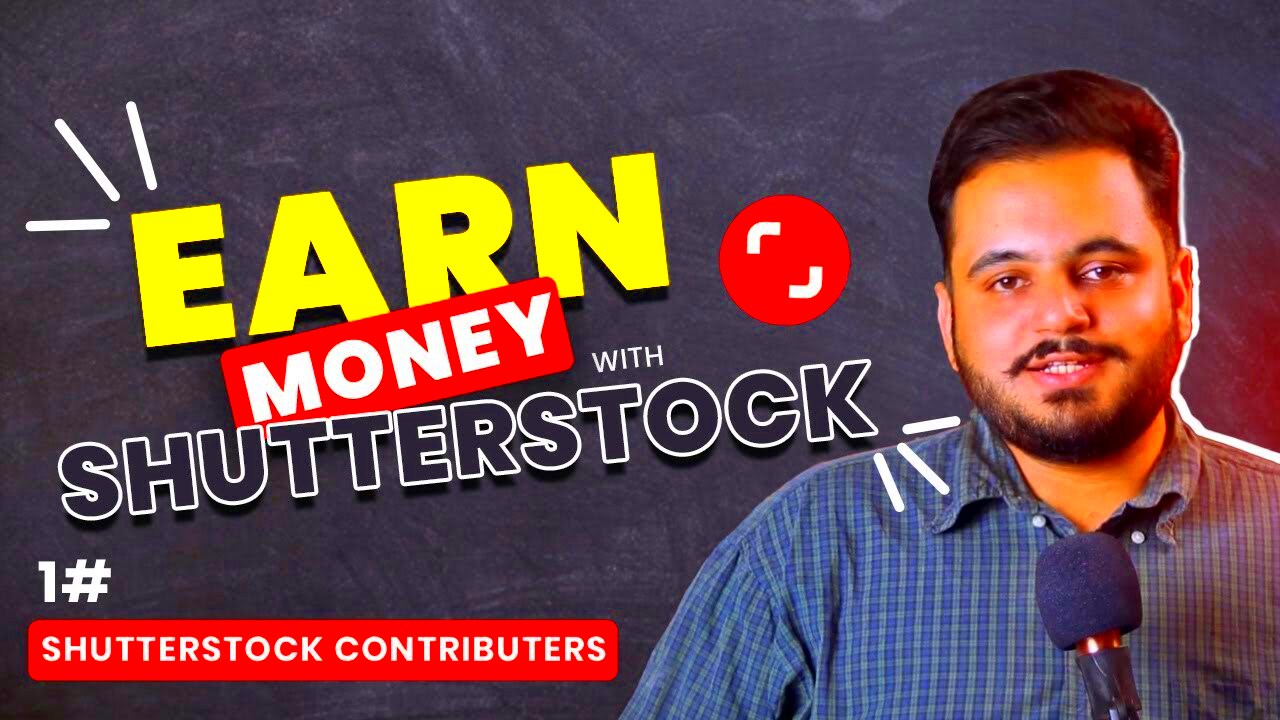Warning: Undefined array key 5 in /home/imgpanda.com/public_html/wp-content/themes/astra/template-parts/single/single-layout.php on line 176
Warning: Trying to access array offset on value of type null in /home/imgpanda.com/public_html/wp-content/themes/astra/template-parts/single/single-layout.php on line 179
Shutterstock has become one of the most popular platforms for photographers, designers, and illustrators looking to make money online by selling their creative work. Whether you’re a professional or just someone with a passion for photography, it’s possible to earn passive income by uploading and licensing your images. This blog will guide you through how to get started and offer tips for boosting your chances of success on the platform.
How to Start Selling Photos on Shutterstock

Getting started as a contributor on Shutterstock is a straightforward process. Here’s a step-by-step guide to help you set up your account and begin selling your photos:
- Create an account: Visit Shutterstock’s contributor page and sign up. You'll need to provide basic information and agree to their terms and conditions.
- Submit your portfolio: Start by uploading a few samples of your work. Shutterstock will review your initial submissions to ensure they meet their quality standards.
- Keywording your images: Once approved, start uploading more images. It’s essential to add detailed and relevant keywords to each photo to help potential buyers find your content.
- Get paid: As customers download your images, you’ll earn royalties. Payments are made monthly once your earnings reach a minimum threshold.
The whole process can take just a few days, and once you’re in, you’re free to upload as much content as you’d like.
Also Read This: How to Remove YouTube from Your TV
Understanding Shutterstock’s Contributor Requirements

Before you begin uploading your images, it’s important to understand what Shutterstock expects from its contributors. Here are some of the key requirements:
- Image Quality: Shutterstock has high standards for image quality. Photos should be sharp, well-lit, and free from noise or other defects.
- Proper Resolution: Your images must meet a minimum resolution of 4 megapixels, though higher resolutions are encouraged for better sales.
- Model and Property Releases: If your photos contain recognizable people or private property, you must include a signed release form.
- No Copyrighted Content: You cannot upload images containing copyrighted logos, brands, or artwork unless you have explicit permission to use them.
By following these requirements, you increase the chances of your images being accepted and, ultimately, sold to customers around the world.
Also Read This: Mastering Networking on LinkedIn for Effective Connections
Key Factors That Influence Your Earnings

Your earnings on Shutterstock can vary based on several factors, and understanding these can help maximize your revenue. Here are the key elements that will impact how much you make:
- Image Quality and Appeal: High-quality, visually appealing images tend to sell better. Consider trending themes and subjects that are in demand, such as business, technology, and lifestyle.
- Portfolio Size: The more images you upload, the higher your chances of making regular sales. Consistently adding new content keeps your portfolio fresh and increases your visibility on the platform.
- Effective Keywording: Properly keyworded images are more likely to be discovered by potential buyers. Use relevant, specific, and trending keywords to ensure your images appear in searches.
- Image Exclusivity: If you choose to make your images exclusive to Shutterstock, you may be eligible for higher earnings compared to non-exclusive content.
- Subscription Plans: Shutterstock’s different subscription models for customers can affect how much you earn. Some plans pay contributors a fixed rate per download, while others are based on a percentage of the sale price.
- Referral Program: Shutterstock offers a referral program, which allows you to earn a commission when people sign up as contributors or customers using your referral link.
By focusing on these factors, you can increase both the volume and value of your sales over time.
Also Read This: What Are the Best Hidden Tools for Creating Stunning Social Media Content in 2025?
How to Optimize Your Images for Better Sales
To stand out on Shutterstock and improve your chances of making sales, you need to ensure your images are optimized both for search visibility and buyer appeal. Here are some effective strategies:
- Choose Popular Themes: Focus on subjects that have a high demand, such as business, technology, health, and nature. Research current trends and seasonal topics to create content that aligns with what buyers are searching for.
- Maintain High Quality: Ensure your images are well-lit, sharp, and free from distracting elements. Buyers are drawn to professional-looking content, so avoid submitting anything that appears amateurish or unpolished.
- Focus on Versatility: Create images that can be used across various platforms, industries, and purposes. Simple, clean images with ample negative space are often preferred by designers for their flexibility.
- Use Descriptive Titles and Keywords: Write titles that accurately describe your image, and use a mix of general and specific keywords. Think like a buyer and consider what terms they might use to search for your photo.
- Edit with Care: Ensure color correction, cropping, and retouching are done carefully to improve the overall quality of your images. Over-editing can sometimes hurt the natural appeal of a photo.
- Upload Regularly: Shutterstock's algorithm often favors contributors who upload content regularly. Consistent uploads help boost your portfolio’s visibility.
By applying these techniques, you’ll increase the likelihood of your images being discovered and purchased.
Also Read This: Understanding YouTube's Compatibility with MKV Files and Other Video Formats
Common Mistakes to Avoid as a Shutterstock Contributor
While selling on Shutterstock can be rewarding, many contributors make mistakes that can hurt their potential earnings. Here are some common pitfalls to avoid:
- Ignoring Shutterstock’s Guidelines: Many new contributors fail to read or follow the platform’s requirements, resulting in rejections. Be sure to understand the image quality standards and submission rules.
- Overlooking Model and Property Releases: If you’re submitting images that include identifiable people or private property, forgetting to include a release form can lead to rejections and wasted time.
- Inconsistent Uploads: Uploading once and then abandoning your portfolio won’t yield consistent earnings. You need to upload regularly to stay relevant in search results and keep your portfolio active.
- Poor Keywording: Using irrelevant or generic keywords can make it harder for your images to be found. Take the time to research effective keywords that are both specific and relevant to your photos.
- Submitting Low-Quality Images: Low-resolution, poorly lit, or blurry images are likely to be rejected and will not appeal to buyers. Focus on submitting only your best work.
- Ignoring Trends: Failing to keep up with market trends can result in your content being overlooked. Stay updated on what’s popular and tailor your uploads to meet current demands.
By avoiding these mistakes, you can increase your chances of success on Shutterstock and build a profitable portfolio over time.
Also Read This: Understanding Shutterstock’s Commission and Fees
FAQ about Making Money on Shutterstock
Here are some common questions contributors often ask about earning money on Shutterstock:
1. How much can I earn on Shutterstock?
Earnings on Shutterstock vary depending on several factors like image quality, portfolio size, and the number of downloads. Contributors earn between 15% and 40% per sale, depending on their lifetime earnings and the subscription plan buyers use. Some contributors earn hundreds or even thousands of dollars monthly, while others may see more modest earnings.
2. How are Shutterstock earnings paid out?
Shutterstock pays contributors once their balance reaches a minimum threshold of $35. Payments can be made via PayPal, Payoneer, or Skrill. Shutterstock processes payments monthly, typically in the second half of the month.
3. Can I sell the same images on other platforms?
Yes, you can sell the same images on other platforms unless you’ve opted for Shutterstock’s exclusive contributor program, which requires that the images be available only on their platform in exchange for higher earnings.
4. What types of images sell best on Shutterstock?
Popular categories include business, lifestyle, technology, nature, and medical-related images. Abstract images and images with room for text are also highly sought after by designers. Keeping an eye on seasonal and trending topics can help guide your content creation.
5. Do I need professional equipment to contribute?
No, while professional equipment can improve image quality, you don’t need it to succeed on Shutterstock. Many contributors use smartphones and affordable cameras as long as the images meet Shutterstock’s quality standards.
Conclusion: Making the Most of Your Shutterstock Journey
Making money on Shutterstock is a rewarding journey, but it requires patience, quality work, and consistency. By understanding the platform's guidelines, optimizing your portfolio, and avoiding common mistakes, you can steadily increase your earnings. Keep learning, stay updated on market trends, and continually upload fresh content to ensure long-term success.
